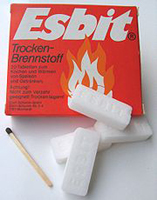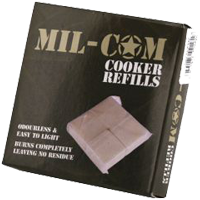The dosage of SG differs quite a lot from G+. Simplified, the quantity SG is about half of G+, the rest is water. For E85, the amount of SG and water is equal. SG is dosed in reverse compared to T50, but as for T50, the dose follows the ethanol content, but since T50 is dosed less for low E-contents, SG is dosed more then, but less for high E-contents. The dose SG reads according to a non-linear graph (here logarithmic). Water, on the other hand, is dosed less for low E-contents and more for high E-contents. Even for water, the dose is according to a non-linear curve. Chemical processes are usually non-linear in nature...
General information about hexamine:
HMTA is an abbreviation for hexamethylenetetramine (hexamine). It is used i.a. for medical purposes to cure urinary tract infections, but also as a fuel in Esbit, fuel tablets for camping kitchens, as an anti-corrosion component for certain additives, for the manufacture of RDX, and in fireworks technology as a flame enlarger by reducing white light. HMTA is a relatively modest and non-toxic substance that dissolves easily in water but also has some solubility in alcohols - glycol, ethanol, etc. But HMTA also dissolves in petrol and petroleum, but to a lesser extent than. The benefit of using HMTA in motor fuels is, among other things, that it is an anti-knock agent. The octane value in petrol increases four times with a content of around 1%. Other powdered anti-knock agents with similar properties are aromatic amines, ferroscene, McMT, iron pentacarbonyl (also other carbonyls), oxalic acid, etc. Triacetin is a liquid and completely non-toxic anti-knock agent based on glycerol.
HMTA is a white powder that gives off the scent of urine. It is also used as a preservative and is then named E239. The fastest way to provide HMTA is to extract it from Esbit tablets or from fuel tablets. You can easily grind the tablets in a mortar. The problem when doing so is that the powder also contains the binder (that which holds the tablets together). The binder appears to be an - easy-to-melt substance - such as paraffin, stearin, wax... I call it “binder” here. This can easily be removed by heat treatment. Fuel tablets contain more binder than Esbit. It seldom involves a risk of heating HMTA, the substance is gasified long before it ignites. You should avoid dissolving HMTA in water, except that it is extremely difficult to get dry, you do not get pure HMTA but a hydrate is formed. Then 5% no longer applies. Fuel tablets also consist of 1,3,5-Trioxane, which is a more volatile substance than HMTA and is greatly reduced under the influence of heat.



As it is more difficult to find genuine G30 glycols at present, it is uncertain whether it is possible to obtain a working product (AG). In any case, this is what I came up to:
BASF G30 the older variant and also called VW class G12 (not G12+) is the name for radiator glycols which have now been replaced by other mixtures. However, some brands remain to satisfy an older car fleet. Exactly what distinguishes G12 from G12+ I do not know, it is a minor mystery regarding the ingredients included, or if these glycols are treated in some special way?



I myself bought the one on the far left (Glysantin G30) at one and a half liters. Then when this was empty, I ordered another one, even though it was only a liter. Although the color and shape of the bottles were identical (the label differed slightly), I noticed a difference in the contents. The new one did not smell like glycol, but rather like detergent. The color was also slightly darker. I could see that the second bottle was not the same as the first. It went well anyway because Mekonomen (a Swedish trade) succeeded to find a four-liter can of Castrol Radicool SF. Glysantin's G30 glycols also contain a number of inhibitors. If you use them directly as fuel, you risk clogging the fuel filter. They must first be washed with oxalic acid. The G30/G12 that is most similar to the old red ones (Biltema) is Radicool SF. This can be used immediately as a component in AG.
Preparation of Glysantin G30
This method does not guarantee that the glycol can be used as a motor fuel, but I still present it as a possible measure, to get rid of or convert the inhibitors that are included in this type of concentrated radiator glycol. The principle is to heat the glycol together with oxalic acid. Oxalic acid is the right choice here as it is well suited for organic use, the ethanediol itself is not affected by the acid.
- Start to weigh the oxalic acid (dihydrate): 2.1% by the weight of Glysantin (this is 2.34% oxalic acid by the amount of glycol).
- Save about one milliliter of oxalic acid per 100 milliliter of glycol.
- Add most of the oxalic acid to the glycol and stir. Try to pulverize formed lumps.
- Heat this mixture so that it becomes boiling hot.
- Stir and allow to cool.
- Add almost all of the remaining oxalic acid, stir and reheat.
- Stir and allow to cool.
- Repeat steps 6 and 7 with the last oxalic acid.
- Let the mixture stand and separate for two days.
- Carefully pour the clear glycol into another container.
- This G30 glycol is ready to be used as a component in SG.
- 100 grams of Glysantin requires 2.1 grams of oxalic acid.
- 100 ml of Glysantin requires 2.34 grams of oxalic acid.
Preparation of HMTA
Before weighing the grounded Esbit powder and mixing it with the glycol, you should first remove the binder. If it is about fuel tablets, it should also be heated, which reduces Trioxan. The melting point of paraffin is low (between 30-40 degrees Celsius or 85-100 degrees Fahrenheit) and the melting point of wax (beeswax) is just over 60 degrees Celsius (140 degrees Fahrenheit). A glass carafe (coffee carafe) is provided. The Esbit powder is added to this and chemically pure petrol is poured over it, so much so that it covers - an excess of petrol. Petrol/Heptane is a good choice because it solves HMTA extremely poorly, which is a requirement one can make. This is heated to boiling - ensure good ventilation during the process! Stir by rotating the carafe at regular intervals. When the binder has melted and dissolved in the petrol, carefully pour the petrol into a smaller container (filtration is not needed because the Esbit powder remains at the bottom of the carafe). Repeat this process at least two more times. The last time, new petrol must be used so that the product is completely free of binder.
Almost all binder dissolves in the petrol and is now part of it. To recycle the expensive petrol, cool this in the freezer for about 20 minutes, then the binder will precipitate. When this has happened, the petrol is filtered out through a paper filter. Remember to filter quickly as the room temperature causes the binder to melt and slip past the filter. A better way is to do the filtration in the freezer. This petrol is now greatly reduced from binder and can once again be used as a refining liquid, next time you need more HMTA... Heating fuel tablets is a simple process, you sprinkle the powder on a shallow bowl, dish, or carafe and place it in a kitchen oven. Suggested temperature and time: 120 degrees Celsius (250 degrees Fahrenheit) for 60 minutes...

It is now possible to weigh and dose this HMTA powder and merge it with the right amount of glycol. The product does not dissolve all HMTA so it is important not to forget to shake the bottle with SG just before dosing. In the beginning, there are many small lumps of HMTA in your freshly prepared SG, so you should wait at least a day before using it, so that the mixture becomes fairly homogeneous first.
Special Glycol:


G+ and SG works best when using glycol containing the substance sodium 2-ethylhexanoate. This is a metal salt of 2-ethylhexanoate acid (sometimes the manufacturers choose this acid 2-EHA instead of the sodium or potassium salt). Typically is glycol caring sodium 2-ethylhexanoate colored red but there are also blue products. However, it is more common for today's red to have potassium instead of the sodium variant, which does not function so well.
 Castrol Radicool SF is a genuine G12 (BASF name: G30) with sodium 2-ethylhexanoate
Castrol Radicool SF is a genuine G12 (BASF name: G30) with sodium 2-ethylhexanoate|
| |
|
| |



